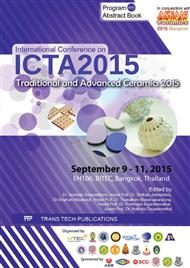[1]
J. Davidovits, L. Buzzi, R. Rocher, D. Gimeno, C. Marini, S. Tocco, Geopolymeric cement based on low cost geologic material, results from the European Research project GEOCIS-TEM In: Davidovits et al., editors., Proceedings of the second international conference Geopolymere '99 (1999).
Google Scholar
[2]
A. Buchwald, Ch. Kaps, Property controlling influences on the generation of geopolymeric binders based on clay, Geopolymer Conference (2002).
Google Scholar
[3]
J. Davidovits, 30 Years of Successes and Failures in Geopolymer Applications, Market Trends and Potential Breakthroughs, Geopolymer Conference (2002).
Google Scholar
[4]
S.J. Lyu, T.T. Wang, T.W. Cheng, T.H. Ueng, Main factors affecting mechanical characteristics of geopolymer revealed by experimental design and associated statistical analysis, Cons. Buil. Mate. 43 (2013) 589–597.
DOI: 10.1016/j.conbuildmat.2013.02.033
Google Scholar
[5]
Y. Huang, M. Han, The influence of a-Al2O3 addition on microstructure, mechanical and formaldehyde adsorption properties of fly ash-based geopolymer products, J. Hazard. Mater. 193 (2011) 90–94.
DOI: 10.1016/j.jhazmat.2011.07.029
Google Scholar
[6]
P. He, D. Jia, S. Wang, Microstructure and integrity of leucite ceramic derived from potassium-based geopolymer precursor, J. Eur. Ceram. Soc. 33 (2013) 689–698.
DOI: 10.1016/j.jeurceramsoc.2012.10.019
Google Scholar
[7]
F. Pelisser, E.L. Guerrino, M. Menger, M.D. Michel, J.A. Labrincha, Micromechanical characterization of metakaolin-based geopolymers, Cons. Buil. Mate. 49 (2013) 547–553.
DOI: 10.1016/j.conbuildmat.2013.08.081
Google Scholar
[8]
J.C.M. Trevino1, C.A. Coles, Kaolinite properties, structure and influence of metal retention on pH, App. Clay Sci. 23 (2003) 133–139.
DOI: 10.1016/s0169-1317(03)00095-4
Google Scholar
[9]
A.G. San Cristóbal, R. Castelló, M.A. Martín Luengo, C. Vizcayno, Zeolites prepared from calcined and mechanically modified kaolins A comparative study, App. Clay Sci. 49 (2010) 239–246.
DOI: 10.1016/j.clay.2010.05.012
Google Scholar
[10]
F. Jroundi, M.T. Gonzalez-Muñoz, A. Garcia-Bueno, C. Rodriguez-Navarro, Consolidation of archaeological gypsum plaster by bacterial biomineralization of calcium carbonate, Acta Biomate. 10 (2014) 3844–3854.
DOI: 10.1016/j.actbio.2014.03.007
Google Scholar
[11]
M. Garg, A. Pundir, Comprehensive study of fly ash binder developed with fly ash – alpha gypsum plaster – Portland cement, Cons. Buil. Mate. 37 (2012) 758–765.
DOI: 10.1016/j.conbuildmat.2012.08.018
Google Scholar
[12]
D.L.Y. Kong, J.G. Sanjayan, Damage behavior of geopolymer composites exposed to elevated temperatures, Cem. Concr. Comp. 30 (2008) 986–991.
DOI: 10.1016/j.cemconcomp.2008.08.001
Google Scholar
[13]
Z. Zuhua, Y. Xiao, Z. Huajun, C. Yue, Role of water in the synthesis of calcined kaolin-based geopolymer, App. Clay Sci. 43 (2009) 218–223.
DOI: 10.1016/j.clay.2008.09.003
Google Scholar
[14]
Y.M. Liew , H. Kamarudin , A.M. Mustafa Al Bakri , M. Luqman, I. Khairul Nizar, C.M. Ruzaidi, C.Y. Heah, Processing and characterization of calcined kaolin cement powder, Constr. Build. Mater. 30 (2012) 794–802.
DOI: 10.1016/j.conbuildmat.2011.12.079
Google Scholar
[15]
P. R. Vora, Urmil V. Dave, Parametric Studies on Compressive Strength of Geopolymer Concrete, Procedia Engineering 51 ( 2013 ) 210 – 219.
DOI: 10.1016/j.proeng.2013.01.030
Google Scholar
[16]
N. Makul, B. Chatveera, Properties of Fly Ash-based Geopolymer Mortar: Influence of Fly Ash Sources and Sodium Silicate (Na2SiO3)/Sodium Hydroxide (NaOH) Ratios, KMUTT Res. Develop. J 36 (2013) 99-125.
DOI: 10.5220/0009445802520258
Google Scholar
[17]
K. Nitin, Longman Science Chemistry 10, Piblished by Dorling kindersley India, (2008).
Google Scholar
[18]
X. Guo, H. Shi, W.A. Dick, Compressive strength and microstructural characteristics of class c fly ash geopolymer, Cem. Concr. Comp. 32 (2010) 142-147.
DOI: 10.1016/j.cemconcomp.2009.11.003
Google Scholar
[19]
K. Boonserm, V. Sata, K. Pimraksa, P. Chindaprasirt, Microstructure and strength of blended FBC-PCC fly ash geopolymer containing gypsum as an additive. Science Asia 38 (2012) 175–181.
DOI: 10.2306/scienceasia1513-1874.2012.38.175
Google Scholar
[20]
K. Boonserm, V. Sata, K. Pimraksa, P. Chindaprasirt, Improved geopolymerization of bottom ash by incorporating fly ash and using waste gypsum as additive. Cem. Concr. Comp. 34 (2012) 819–824.
DOI: 10.1016/j.cemconcomp.2012.04.001
Google Scholar
[21]
D. Hardjito, S. E. Wallah, D.M.J. Sumajouw, B.V. Rangan, Factors influencing the compressive strength of fly ash-based geopolymer concrete, Civil Engineering Dimension 6 (2004) 88–93.
DOI: 10.1080/13287982.2005.11464946
Google Scholar
[22]
Z. Shan, I. Porter, J. Nemcik, Q. Qiao, Effect of different curing conditions on the compressive and flexural properties of Plaster of Paris, 14th Coal Operators' Conference, University of Wollongong (2014) 103-108.
Google Scholar
[23]
D. Khale, R. Chaudhary, Mechanism of geopolymerization and factors influencing its development: A review. J. Mate. Sci. 42(3) (2007) 729-746.
DOI: 10.1007/s10853-006-0401-4
Google Scholar


